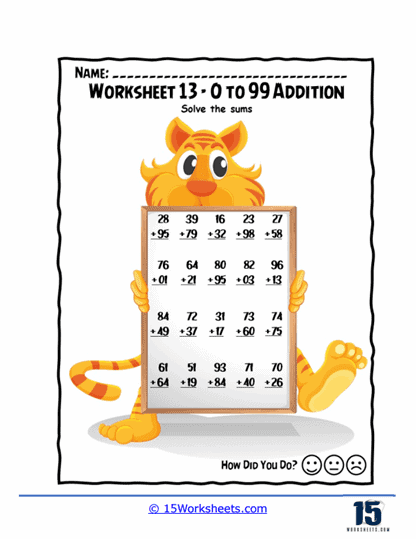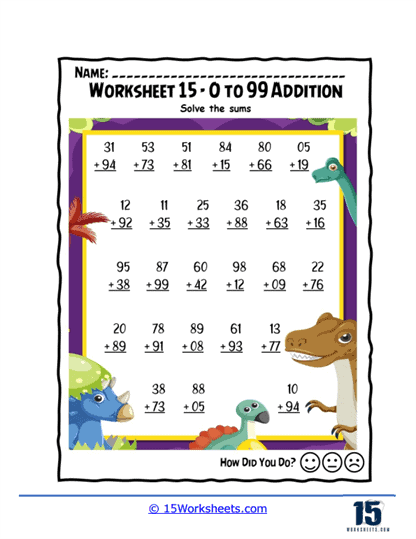Adding 0 to 99 Worksheets
About These 15 Worksheets
These worksheets provide a structured platform for honing basic arithmetic skills, particularly in the realm of addition. By incorporating various types of exercises, these worksheets cater to different learning styles, reinforcing the fundamental principles of addition while gradually introducing complexities. Let’s delve into the diverse exercises typically found in these worksheets and elucidate how their practice can enhance students’ understanding of basic math operations.
By incorporating diverse exercises encompassing basic addition, word problems, regrouping, and interactive elements, these worksheets cater to varied learning styles and promote holistic skill development. Through consistent practice with these worksheets, students not only enhance their addition proficiency but also cultivate critical thinking, problem-solving, and confidence in their mathematical abilities, laying a solid foundation for future mathematical endeavors.
Types of Exercises
At the foundational level, adding 0 to 99 worksheets feature basic addition exercises aimed at acquainting students with the process of combining numbers. These exercises involve adding single-digit numbers to double-digit numbers, with or without carrying over. For instance:
Vertical Addition
Vertical addition exercises are prevalent in these worksheets as they mimic the format commonly used in classrooms. Students are presented with columns of numbers to add, fostering familiarity with the vertical addition method. These exercises often include both single-digit and double-digit numbers, preparing students for more complex additions in higher grades.
Horizontal Addition
In contrast to vertical addition, horizontal addition exercises offer a different perspective on combining numbers. These exercises present numbers in a horizontal arrangement, encouraging students to mentally calculate sums without relying on the columnar structure. Horizontal addition enhances mental math skills and fosters flexibility in arithmetic computation.
Missing Addend Exercises
Missing addend exercises aim to reinforce the concept of addition by allowing students to solve for the missing number in an equation. These exercises enhance students’ ability to understand the relationship between the sum and the addends. For example, given the equation 42 + ___ = 89, students must determine the missing addend.
Coloring and Picture Addition
Coloring and picture addition exercises infuse an element of creativity and engagement into traditional arithmetic practice. Students are presented with visual representations such as pictures, shapes, or objects, each associated with a numerical value. By adding the values assigned to these visual elements, students practice addition while simultaneously engaging their visual and spatial cognition.
Regrouping and Carrying Over
As students progress in their arithmetic skills, adding 0 to 99 worksheets introduce exercises involving regrouping or carrying over. These exercises require students to adjust their addition strategy when the sum of digits in a column exceeds nine. By mastering regrouping techniques, students develop a deeper understanding of place value and numerical manipulation.
The Benefits of These Worksheets
Engaging with these worksheets offers numerous benefits for students in developing their basic math operation skills:
Conceptual Understanding
Through a variety of exercises, students gain a solid conceptual understanding of addition principles, including place value, regrouping, and the relationship between addends and the sum. By engaging with diverse problems that involve different combinations of numbers, students learn to grasp the underlying concepts behind addition. For instance, when they encounter exercises requiring regrouping, they understand the significance of place value and how digits in different places contribute to the overall sum. This foundational understanding lays the groundwork for more advanced mathematical concepts and problem-solving strategies.
Regular practice with these worksheets hones students’ addition skills, fostering fluency and accuracy in arithmetic computation. As students encounter diverse exercises ranging from basic addition to more complex problems involving regrouping, they develop strategies to tackle different types of addition problems efficiently. With each worksheet completed, students refine their addition techniques, becoming more adept at performing calculations accurately and swiftly. This continual practice not only reinforces their understanding of addition principles but also cultivates a sense of confidence in their mathematical abilities.
Problem-Solving Skills
Word problems and missing addend exercises encourage students to apply addition skills in real-world contexts and solve mathematical challenges creatively. By deciphering the problem, identifying relevant information, and executing the appropriate addition operation, students sharpen their problem-solving abilities. These exercises require students to analyze situations, extract essential information, and devise a plan to arrive at the correct solution. Through tackling word problems, students develop critical thinking skills and learn to apply addition in practical scenarios, preparing them for real-life mathematical challenges they may encounter.
Horizontal addition exercises and rapid-fire drills promote mental math agility, enabling students to perform addition calculations swiftly and accurately without relying heavily on written methods. By practicing horizontal addition, where numbers are arranged in a row rather than in columns, students enhance their ability to perform mental calculations efficiently. Rapid-fire drills further reinforce mental math skills by challenging students to solve addition problems within a limited time frame. As students progress, they become more proficient in performing mental addition, which not only improves their computational speed but also boosts their confidence in their mathematical abilities.
Visual and Spatial Reasoning
Coloring and picture addition exercises stimulate visual and spatial reasoning skills, as students must interpret visual representations and associate them with numerical values. This multisensory approach enhances comprehension and retention of addition concepts. By engaging with visual stimuli such as images, shapes, or objects, students develop the ability to visualize addition processes and manipulate numerical representations in their minds. This strengthens their spatial reasoning skills and reinforces their understanding of addition principles through hands-on, interactive activities.
Confidence Building
As students progress through adding 0 to 99 worksheets, they experience a sense of accomplishment as they successfully tackle increasingly challenging exercises. This builds confidence in their mathematical abilities and encourages them to embrace mathematical challenges with enthusiasm. With each worksheet completed, students gain a greater sense of mastery over addition concepts and techniques. This sense of achievement fosters a positive attitude towards mathematics, empowering students to approach mathematical problems with confidence and resilience. As a result, students become more motivated to tackle complex mathematical tasks and explore new areas of mathematical inquiry.















